
Menu:
Behrooz Parhami's Poetry Page
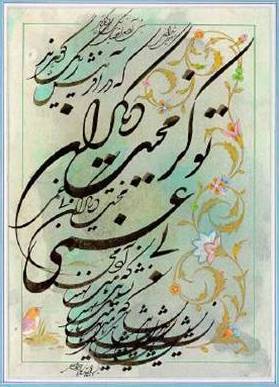
Page last updated on 2024 March 15
I have had a longstanding interest in poetry, particularly the works of classical Persian poets. I enjoy the works of many poets, both ancient and contemporary, I believe that each brings forth a unique world view and contributes fresh structures and formats. My favorite medieval Persian poets/philosophers include Sa'adi (1184-1283+), Mowlavi (aka Rumi, 1207-1273), and Hafez (1315-1390). Among Twentieth-Century Persian poets, I appreciate the works of Malek o-sho'ara Bahar (1889-1957), Parvin E'tasami (1907-1941), and Mohammad-Hossein Shariar (1906-1988).
My own style of Persian poetry is varied, but I particularly enjoy composing poems for momentous occasions, with initial letters of verses or half-verses spelling a particular message. This feature is evident in my annual Norooz poems, some of which appear on this page. More examples of poems written on other topics, or for other occasions, will be added in future.
Traditional Norooz Poems
Poems in Praise of Honorable People (forthcoming)
Miscellaneous Poems
Mowlavi: "If your thought is a rose, you are a rose garden; and if it is a thistle, you are fuel for the fire."
Sa'adi: "The children of Adam are limbs of one body, having been created of the same essence. When a limb is afflicted with pain, other limbs become restless as well. Anyone who feels no pain at the sufferings of others, is not fit to be called human." (shown in the calligraphic image above)
Traditional Nowruz Poems
Each year, since 2002, I have composed a traditional Persian poem that celebrates the arrival of spring and its gifts of renewal and hope, challenging myself by having the initial letters of the poem's verses or half-verses spell a cheerful or congratulatory message. A sampling of these poems follows the image below.
Nowruz coincides with the first day of spring, which is also the start of the Persian calendar year. It has a special place among traditional observances in Iran and other Persian communities. Nature's renewal with the arrival of spring makes this holiday an occasion for joy and optimism, themes reflected in the poems that follow. Paying courtesy visits to members of one's extended family and spending time with loved ones are among Nowruz rituals that have survived for thousands of years in the face of adversities and efforts of certain groups to obliterate festivals and other symbols of pre-Islamic Iran. (Read more about Norooz)
Note: There was a long-running debate among the Persian-speaking communities about the proper English spelling for Nowruz. Before converging on Nowruz, which is used by a vast majority of Iranians and by the United Nations, preferred spellings included Norooz, Nowrooz, and Norooz.

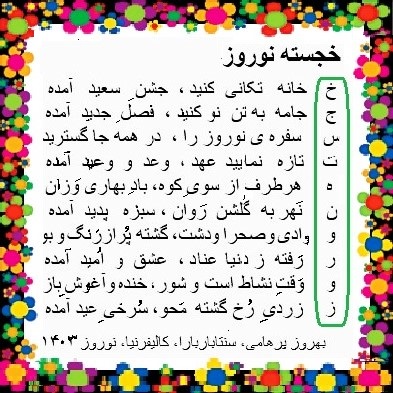
Here is my spring 2024 (1403 in the Persian calendar) poem for Nowruz, spring, and the Iranian New Year. Initial letters of the poem's verses spell its Persian title, "Khojasteh Nowruz." A rough English translation follows.
Clean out your home for a momentous celebration
Wear the freshest clothes, a new season is upon us
Unroll the Nowruz spread in homes near and far
Renew your loyalties, hope and promise are here
The spring breeze is blowing from the mountainside
Streams are flowing, the fields have turned green
The hills and plains teem with fragrance and color
Enmity has disappeared, love and hope now rule
It is time for joy, passion, laughter, and open arms
Pale faces have turned red from the joy of Nowruz
Looking forward to a year with a heartfelt joy that makes it easier to compose my annual Nowruz poem!
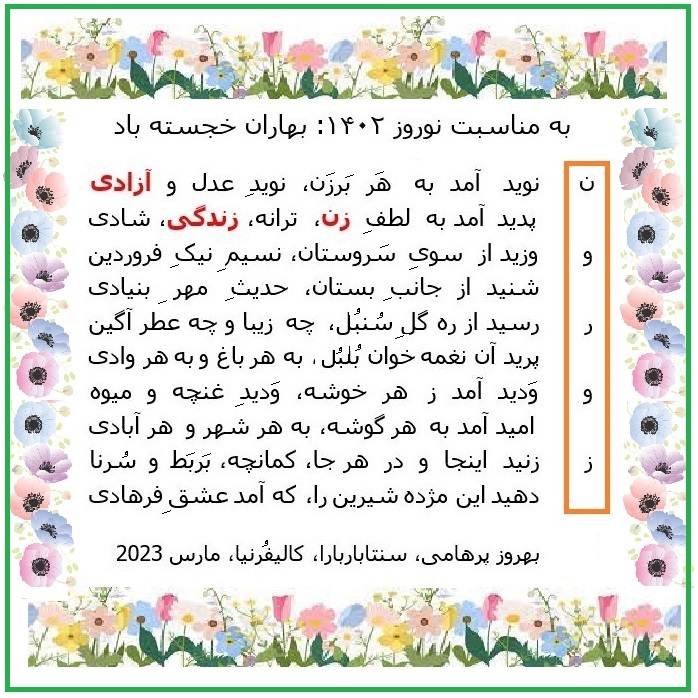
Here is my spring 2023 (1402 in the Persian calendar) poem celebrating Nowruz, spring, and the Iranian New Year. Initial letters of the poem's verses spell its Persian title, "Nowruz." A rough English translation follows.
Justice and freedom descend on every borough
Thanks to women, we have songs, life, and joy
A spring breeze blows from the cypress grove
Bringing with it the story of ultimate affection
The beautiful and fragrant hyacinth has arrived
The chirping nightingale is flying all around
Goodwill emanates from blossoms and fruits
Hope is in the air, of every township and village
Do play the fiddle, harp, and bugle everywhere
Reassure Shirin that a Farhad-like love is here
As was the case for the last three springs, bringing myself to be cheerful wasn't easy this year!
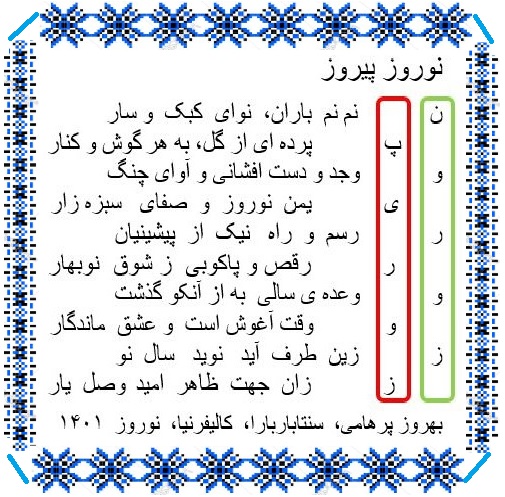
Here is my spring 2022 (1401 in the Persian calendar) poem celebrating the ancient Iranian Nowruz/Norooz Festival, spring, and the Iranian New Year. Initial letters of the poem's first and second half-verses spell its Persian title, "Nowruz Pirooz," which translates to "Winsome/Triumphant Nowruz." A rough English translation follows.
Kiss of raindrops, chirps of partridges and starlings
Flowers draping each stretch and every bend
Cheerfulness, dancing, and the strumming of harp
Charm of Nowruz and tranquility of green plains
Noble traditions and principles from our ancestors
Dancing and stomping from the delight of spring
The promise of a year much better than the last
Time for passionate embraces and lasting love
New year's gifts arriving from one direction
Hopes of uniting with the beloved, from another
As was the case for the last two springs, bringing myself to be cheerful wasn't easy this year, given continued challenges from the pandemic, with the outbreak of the senseless war in Ukraine adding to the difficulty.
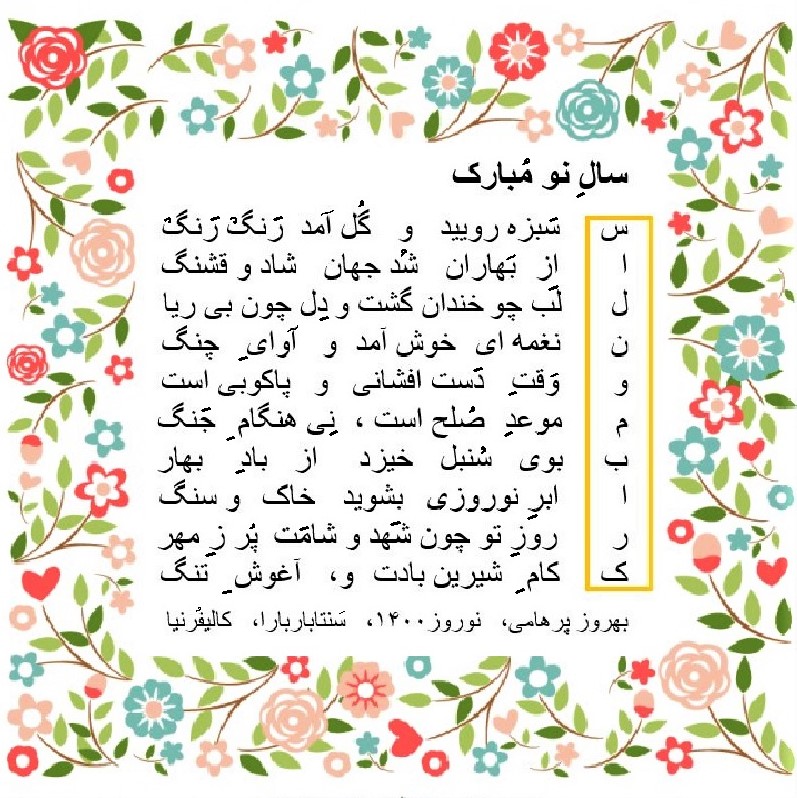
Here is my spring 2021 (1400 in the Persian calendar) poem celebrating the ancient Iranian Norooz/Nowruz Festival, spring, and the Iranian New Year. Initial letters of the poem's first and second half-verses spell its Persian title, "Saal-e No Mobarak," which translates to "Happy/Auspicious New Year." A rough English translation of the poem follows.
Welcome the greenery, and the luminous flowers
The spring's arrival, and the buoyancy of lovers
With lips smiling, along hearts chaste and pure
Heavenly voices and tunes, will delight us for sure
It's time for adventure, time to sing and dance
Time for lasting peace, let's not give war a chance
The hyacinth's fragrance is in the spring breeze
The gentle Nowruz rain washes the rocks and trees
May your day be sweet, may love fill your night
May you be endowed, with merriment and delight
This year, like 2020, it was particularly difficult for me to get in the cheerful mood needed to compose the festive poem. I ended up going to my special retreats along the beach and in a nearby nature preserve to focus on beauty and serenity and forget about the pandemic and the nerve-wracking political scene in the US over the past 4-5 years. I recite the poem in this 2-minute video.
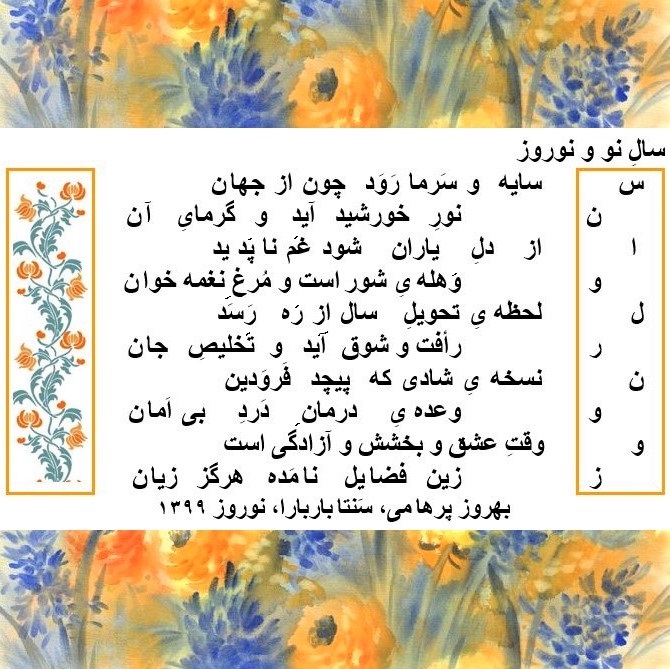
Here is my spring 2020 (1399 in the Persian calendar) poem celebrating the ancient Iranian Norooz/Nowruz Festival, spring, and the Persian New Year. I must admit that in 2020, with the grim political situations in the US and Iran, and with the coronavirus spreading worldwide, I found it difficult to muster positivism and hope, and had to work harder as a result. Here is the poem, whose half-verse initial letters spell "New Year" and "Norooz." It is with pleasure that I dedicate this poem to my dear family members and friends, a couple of weeks before the Persian New Year! In this 2-minute video, I recite the poem (Facebook version, Twitter version).
For spring 2019 (Norooz 1398 in Persian calendar), I decided to take on an even greater challenge, composing my poem to celebrate Norooz in the first half-verses and women in the second half, with the initials of the former spelling "Norooz" and the initials of the latter spelling "Women's Day" (in Persian).
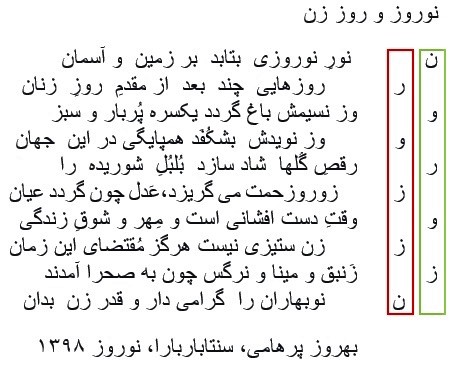 I love puzzles and such compositions are puzzle-like. Starting with the desired initial letters that spell my hidden message, and notions that I would like to include in the poem (spring, flowers, joy, renewal, growth, ... for Norooz, and equality, respect, rights, justice, ... for Women's Day), I go to work trying to put my sentiments into words, while observing the rhyming schemes that have made classical Persian poetry a joy to read/recite. This year, progress was slow in the first couple of days, but I eventually pulled everything together and finished the job by Women's Day (March 8), when I first published the poem. In this 2-minute video, I recite the poem (Facebook version, Twitter version). This image contains both the poem and a Persian version of the description above.
I love puzzles and such compositions are puzzle-like. Starting with the desired initial letters that spell my hidden message, and notions that I would like to include in the poem (spring, flowers, joy, renewal, growth, ... for Norooz, and equality, respect, rights, justice, ... for Women's Day), I go to work trying to put my sentiments into words, while observing the rhyming schemes that have made classical Persian poetry a joy to read/recite. This year, progress was slow in the first couple of days, but I eventually pulled everything together and finished the job by Women's Day (March 8), when I first published the poem. In this 2-minute video, I recite the poem (Facebook version, Twitter version). This image contains both the poem and a Persian version of the description above.
Here is the 2018 (1397) edition of my traditional Norooz poem. Initial letters of the poem's first and second half-verses spell its Persian title, "Khojasteh Norooz," which translates to "Felicitous Norooz." A rough English translation follows.
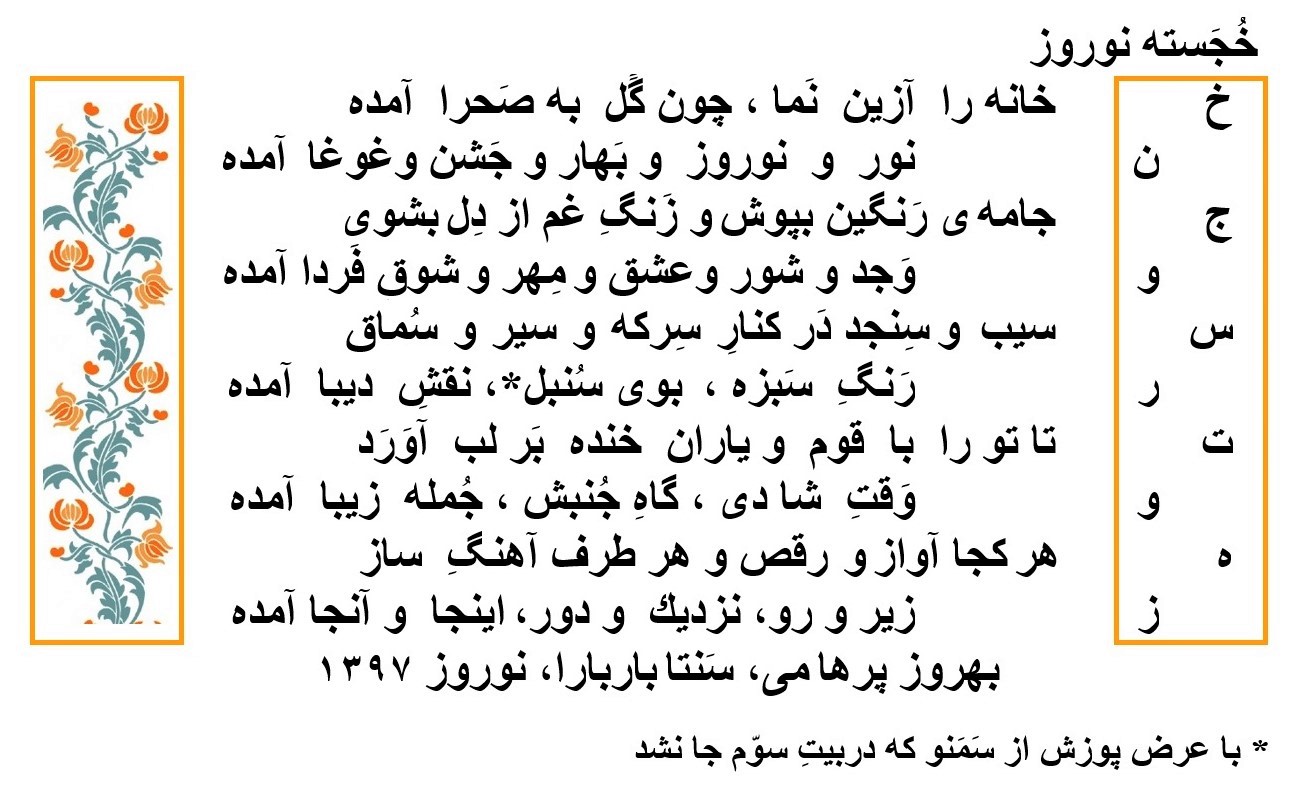 Beautify your home, for the plain is covered with flowers
Beautify your home, for the plain is covered with flowers
Light, Nowruz, spring, festivity, hubbub, all looming towers
Don colorful clothes, wash sorrow's rust from your mind
Joy, passion, love, affection, zeal for life are right behind
Apple, oleaster, vinegar, garlic, sumac, are all on a spread
Hue of grass, smell of hyacinth, fancy silk patterns in red
Smiles adorn your family and friends, and your own face
The time for merriment and movement has come with grace
Songs and dance all around, sounds of music everywhere
Beneath and above, near and far, right here and over there
— Behrooz Parhami, Norooz/Spring 2018

For 2017, I decided to challenge myself further by having the initials in quarter-verses ("nim-mesra'e") also be part of the message. Reading downward, from right to left, the initials spell "NOROOZ | SAAL-E NO | BAR HAMEH | MOBAARAK" (Persian for "Happy Norooz and New Year to All").
The following Persian poem, composed for Norooz 1395 (spring 2016), contains "Saal-e No Mobaarak" ("Happy New Year") in the initial letters highlighted in its right margin. A rough English translation follows.
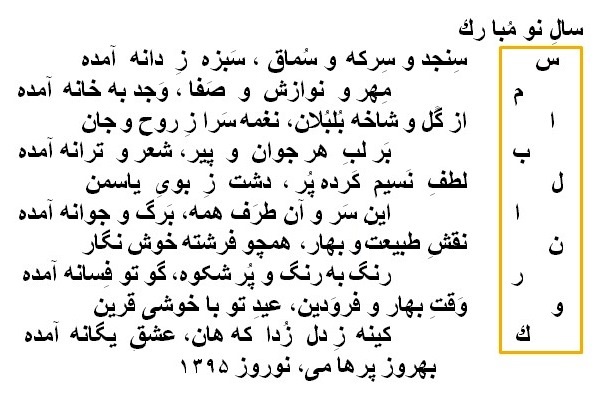 HAPPY NEW YEAR
HAPPY NEW YEAR
Oleaster, vinegar, sumac, and seeds sprouting into green
Love, caress, pleasantness, joy, have all entered the scene
From flowery twigs, the nightingale sings bright and bold
Odes and songs are on people's lips, be they young or old
The spring wind spreads jasmine's fragrance everywhere
Leaves and buds are aplenty, they emerge here and there
Image of nature in spring, is like an angel's warm glory
Rainbow-toned in colors, splendored like a fabulous story
In this spring and New Year, may your holidays be bright
Clear spite away, embrace an affection that's out of sight
— Behrooz Parhami, Norooz/Spring 2016
The Persian poem on the right below, composed for Norooz 1394 (spring 2015), contains "Pirooz Norooz" (Winsome/Triumphant Norooz) in the initial letters highlighted in its right margin. Here is an English translation:
Let's put winter to bed, spring is about to rise
The fields are all bejeweled, they seem like paradise
Brighter is our daytime, from the buoyant rays of sun
Moonshine makes our evening full of earnest fun
Gentle breeze and raindrops supply much needed lift
To greenery and flowers, they offer a precious gift
Prancing with delight, dancing too, you must
Follow the nightingale, sing with blissful lust
Lushness, fortune, and joy, are slated to arrive
If your heart's wide open, therein love will thrive
This poem was published in iranian.com on March 17, 2015.
The Persian poem on the left below, composed for Norooz 1393 (spring 2014), hides "Norooz khojasteh" (Auspicious Norooz) in the initial letters. The poem was published in iranian.com on March 20, 2014.
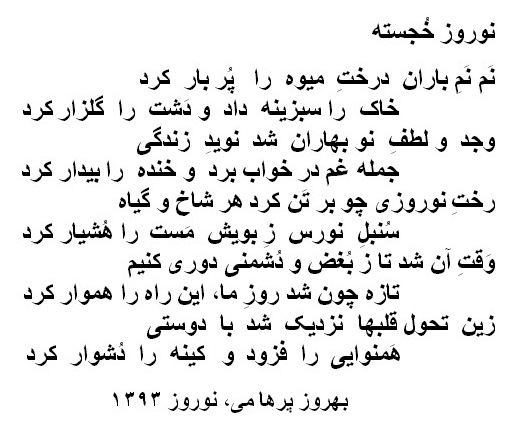
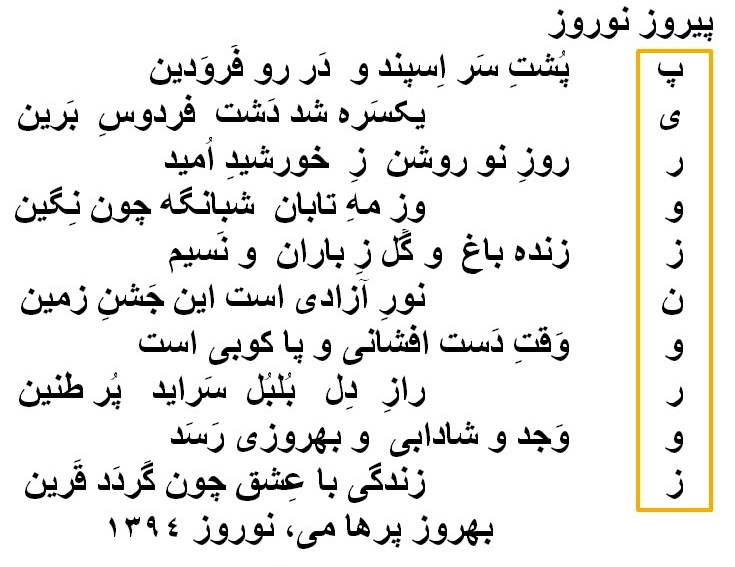
The Persian poem on the right below, composed for Norooz 1392 (spring 2013), contains "Norooz mobaarak" (Happy Norooz) in the initial letters highlighted in its right margin. Here is an English translation:
The sweetbriar's in the garden, so is the breeze of spring
Multiplied joy's what our festive celebrations bring
Gentle raindrops fall, as the cold winter cowers
The new year follows on the heels of greenery and flowers
Paleness, pain, and hurt, get erased from our faces
Mother Earth's cheeks turn rosy from the fire's embraces
May the arrival of spring bring you joy and affection
And may your fortune be far-flung in every direction
The festival of Norooz is our forbearers' precious gift
May your mouth be sweet, and your spirit a fragrant wift
The Persian poem on the left below, composed for Norooz 1390 (spring 2011), hides "Iran, Norooz" in the initial letters highlighted in its right margin. The poem appeared in iranian.com on March 15, 2011.
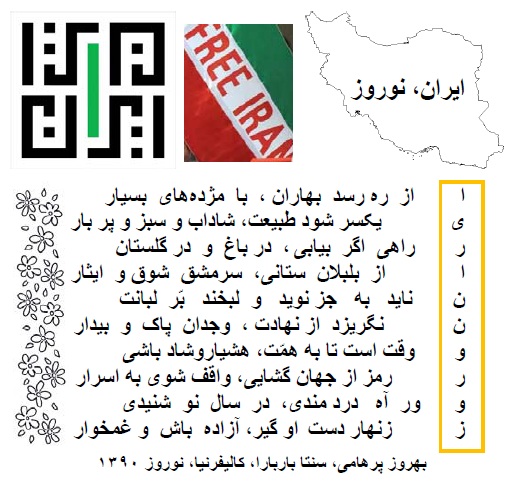
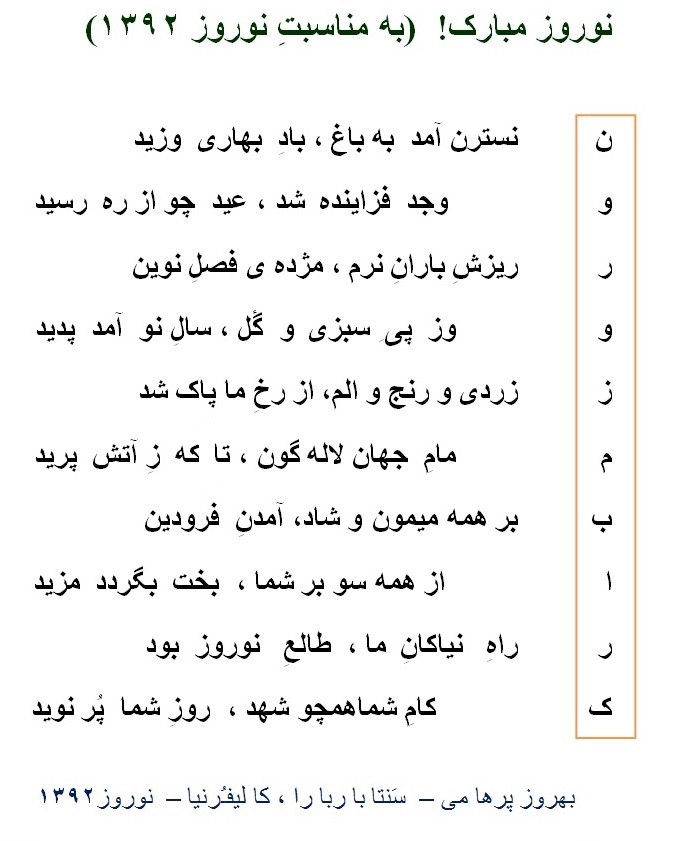
The Persian poem on the right below, composed for Norooz 1389 (spring 2010), hides "Saal-e no mobaarak" (Happy new year) in the initial letters highlighted in its right margin. The poem, which follows the mood and form of a verse by Mowlavi (reproduced at the very beginning), describes nature's beauty at the onset of spring and the many gifts it brings to us humans. The poem appeared in iranian.com as a blog post on March 17, 2010.
The Persian poem on the left below, written for Norooz 1388 (spring 2009) carries the message "Saal-e no mobaarak" (Happy new year) in the initial letters highlighted in its right margin. The poem was published in iranian.com on March 20, 2009.
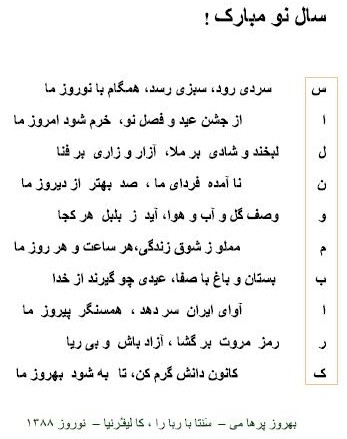
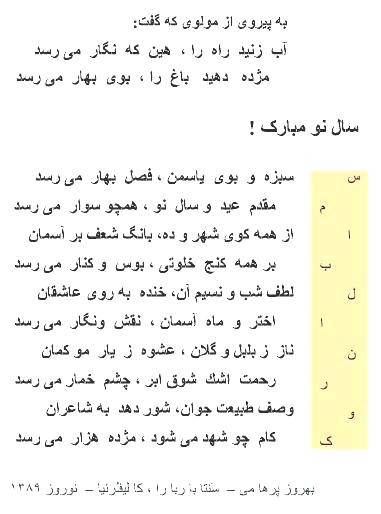
The poem on the right below, celebrating Norooz 1387 (spring 2008), follows the mood and form of a popular couplet by Mowlavi. Mowlavi's couplet is reproduced at the beginning of the image. Professor Parhami's poem, entitled "My Norooz," hides the message "Behrooz P" in its half-verse initials.
The Persian poem on the left below was written for Norooz 1386 (spring 2007). It spells out "Shaad baad Noroozat" (May your Norooz be joyous) with the initials of its half-verses. The names of B. Parhmi's three children (Sepehr, Sepand, and Sepideh) also appear in the poem.
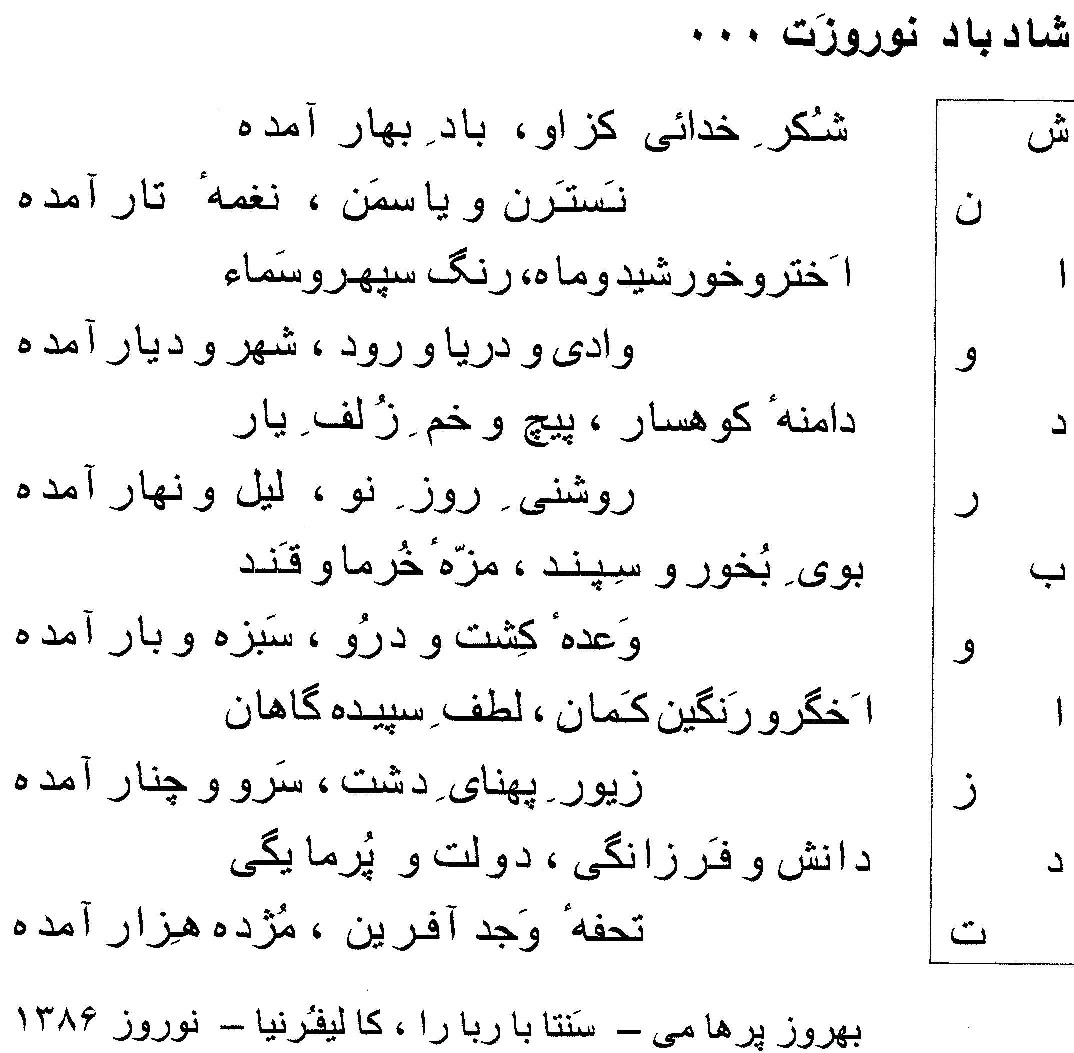
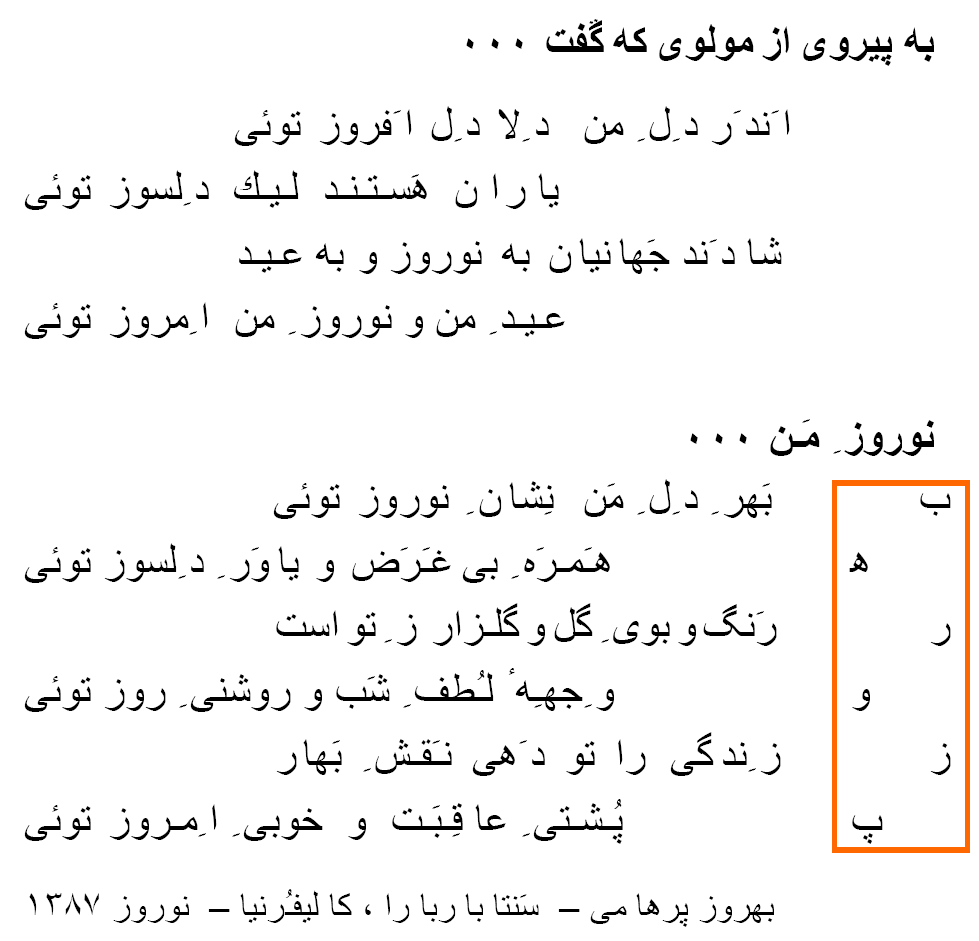
The Persian poem on the right below, was written for Norooz 1384 (spring 2005). Its initials spell out the message "Hamisheh Norooz" (Norooz, forever).
The Persian poem on the left below, which was written on the occasion of Norooz 1383 (spring 2004), spells out "Behrooz Parhami" with its initials.
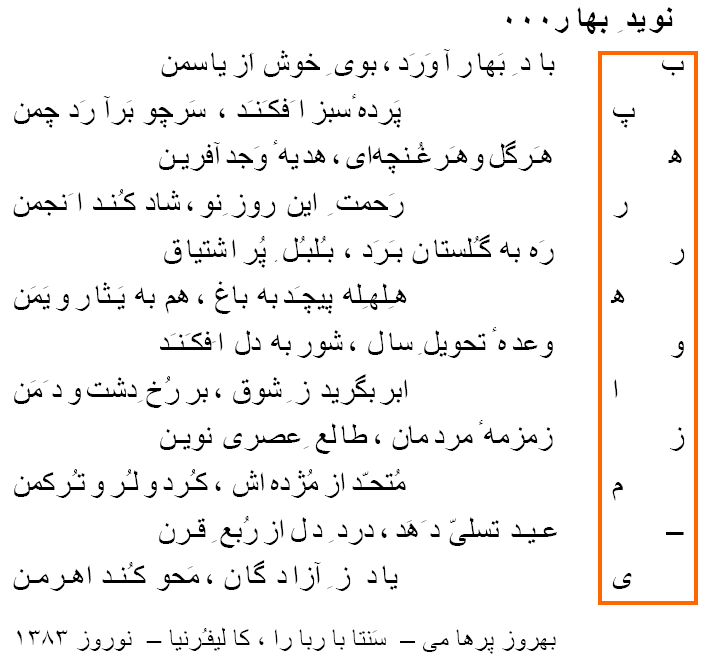
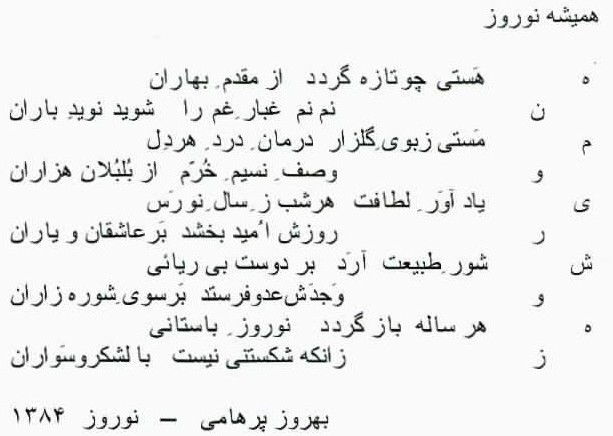
The Persian poem on the right below was written to celebrate Norooz 1382 (spring 2003). Its initials spell out the message "Behrooz Norooz" (Prosperous Norooz).
The poem on the left below was written to celebrate Norooz 1381 (spring 2002). Its half-verse initials spell out the message "Norooz mobaarak" (Auspicious Norooz). It was published in iranian.com on March 14, 2002.
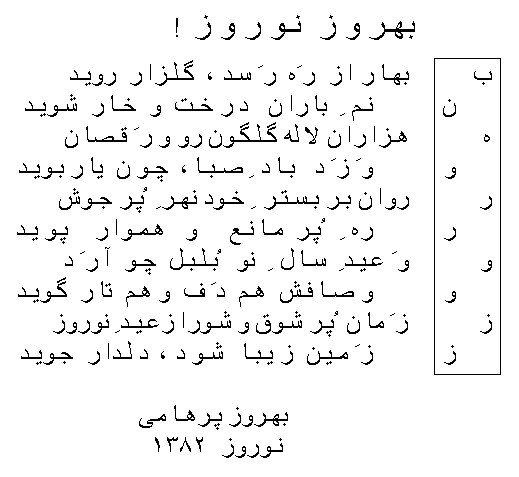
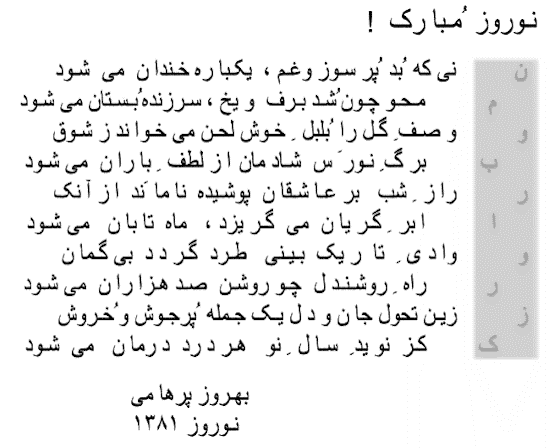
Miscellaneous Poems
Poems on various topics will be posted to this section in due course.
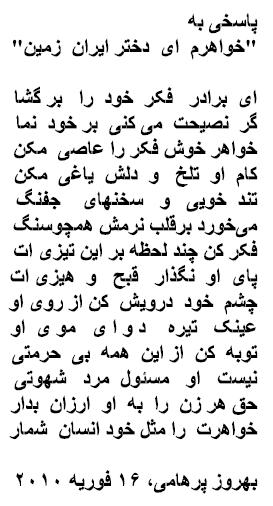
Here is the first example: a response to a poem appearing on a banner in Tehran, entitled "Khaaharam, ey Dokhtar-e Iran-Zameen" (My Sister, Oh Daughter of the Land of Iran!), that instructed women on how to behave and what styles/colors of clothes to wear. The banner poetry offended my senses of liberty, fairness, and justice, especailly since I was reading The Politics of Women's Rights in Iran (Arzoo Osanloo, Princeton Univ. Press, 2009) at the time. A review of the said book appears in my Blog & Books Web page; see the entry for 2010/03/10. This response poem appeared in iranian.com on February 17, 2010, where you can also see the original banner-poem.
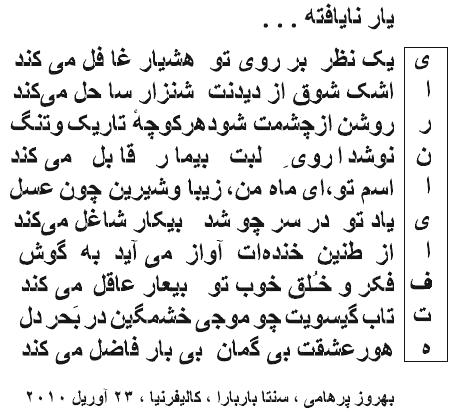
The poem on the right is entitled "The Unfound Soulmate." This piece, which had been in the works for a long time, was finally completed on April 23, 2010. It contains a kind of wish list of highly desirable features in an as yet unfound soulmate.
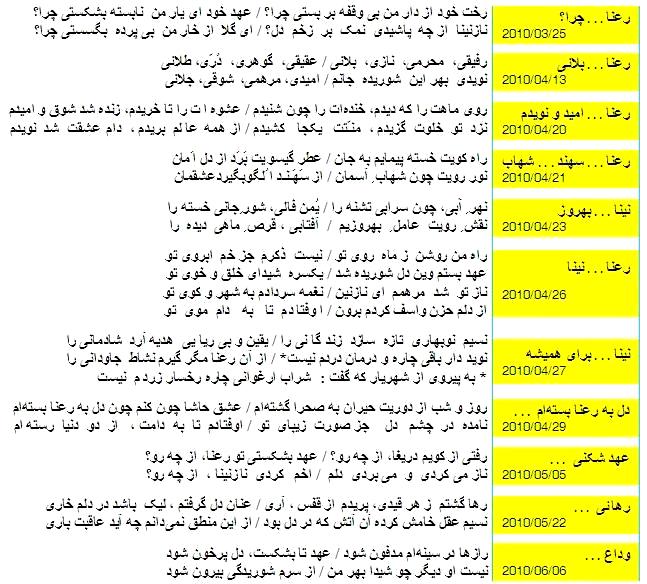
The "Ra'na collection," shown below, contains a series of poems written for Ra'na, a very special friend who unexpectedly entered my life in early 2010 and just as abruptly left it in mid 2010. The initials of verses or half-verses spell "Ra'na," or her other name "Nina." In the fourth poem, "Sahand," a majestic mountain in Iran, is used as a metaphor for stability and fortitude.
More poems to come.